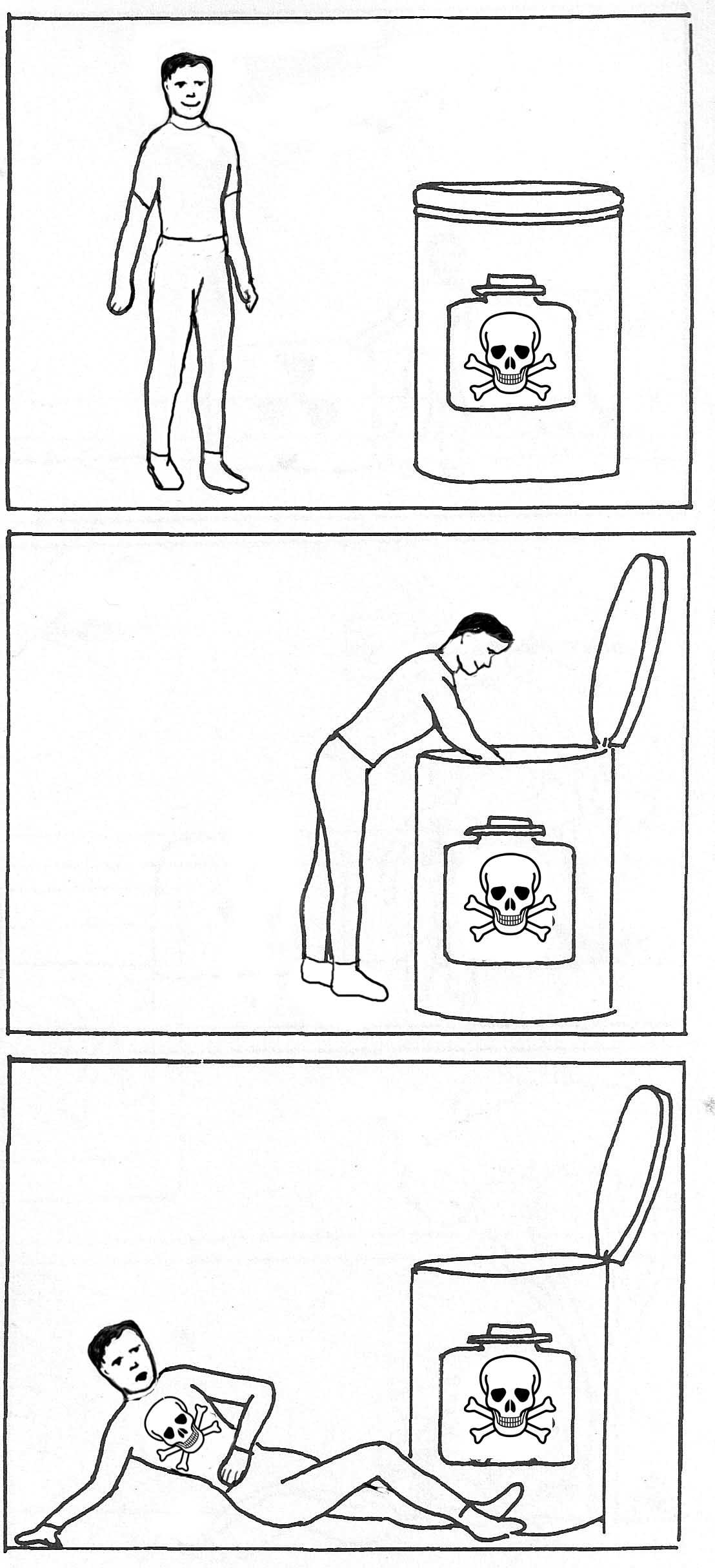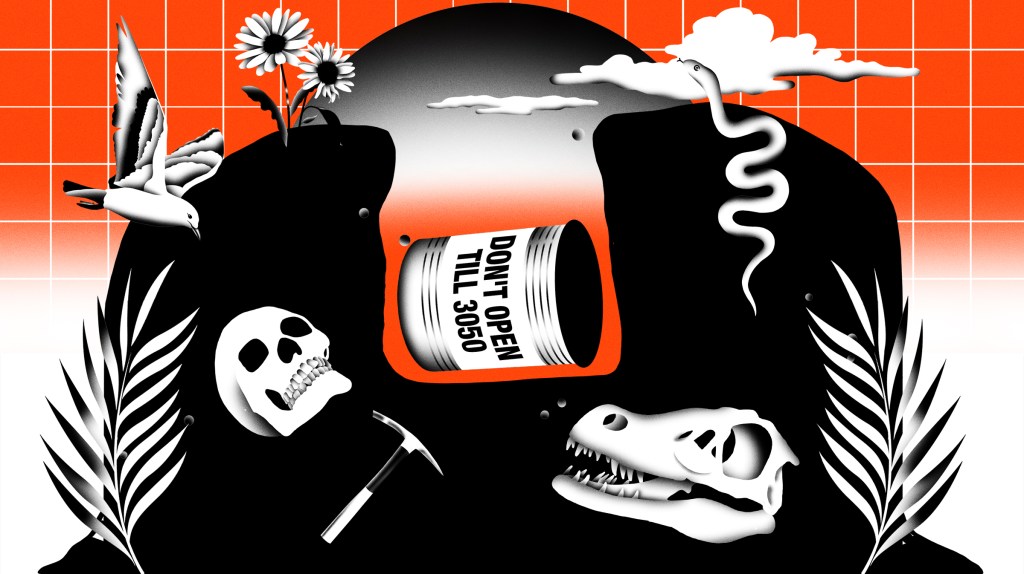This story appears in VICE magazine’s Dystopia and Utopia Issue. Click HERE to subscribe to VICE magazine.
At first, Jon Lomberg thought it was a joke. When the late Carl Sagan, his friend and mentor, told him about a US Department of Energy plan to future-proof an atomic waste site for 10,000 years, he wasn’t sure it could be real. But a few years later, in 1990, Lomberg signed on to help design the warning marker of this tomb of the Cold War.
Videos by VICE
He had received a letter from Sandia National Laboratories in Albuquerque, New Mexico, with the unusual proposal. Sandia needed help developing a marking system to deter humans from entering America’s only active nuclear waste repository, the Waste Isolation Pilot Plant (WIPP) for the next 10,000 years. It would represent humanity’s longest attempt at consciously communicating through time. As someone long invested in “unique communication problems,” Lomberg was intrigued.
Once the government settled on the location for the WIPP—an internment site dug from beds of ancient ocean salts—as the template for future nuclear waste disposal, it set about tackling an Environmental Protection Agency regulation to designate the site with “the most permanent markers, records, and other passive institutional controls practicable” to convey the danger contained within.
Sandia, contracted by DoE to work on the project, formed a Markers Panel of unique communicators, experts in a field that lacked expertise, to find a solution. Lomberg, a specialist in the search for extraterrestrial intelligence (SETI) and arguably the most experienced creator of messages intended for other times and beings, was among those selected. “They believed they had solved the technical problem,” says Lomberg. “We were there to solve the human one.”
*
Lomberg, now nearing 70, has made some of the most unusual, durable, and far-flung artifacts ever produced by humankind, artifacts that reflect the ways in which technology, for better or worse, has expanded the mark and reach of civilization across time and space. All told, he has designed or helped design six artifacts that have successfully left the bonds of Earth with another in the works, and he has amassed a large body of artwork addressing the puzzling, long-term communications problems inherent to depicting our universe to far-future audiences.
Prior to the WIPP assignment, Lomberg worked under Sagan, who chaired the NASA committee behind the Voyager Golden Record, a time capsule meant to impart the story of our world to aliens. Launched aboard NASA’s Voyager probes in 1977, the double record would become the first human-made object to ever leave our solar system. It contained everything from scientific diagrams, to music from across cultures and time periods, to the images and sounds of humans and animals that Lomberg helped create and select.

Lomberg was also project director for the Planetary Society’s Vision of Mars, a message launched in August 2007 from Earth to prospective human inhabitants of the Red Planet. Delivered via the Phoenix lander in May 2008, the “vision” took the form of a silica glass mini-DVD embedded with literature, art, and personal messages about Mars from space visionaries, including Sagan. “When we colonize Mars,” Lomberg says, “I will be part of their prehistory.”
It all started at age 7, when Lomberg saw a picture of Messier 81, a large spiral galaxy 12 million light-years from Earth. “I thought it was the most beautiful, daunting thing I’d ever seen,” says Lomberg, who was inspired by the vastness of the universe and the “galactic civilizations that could be all around us.”
It was his own artistic inclination, coupled with an interest in astronomy and a fascination with science fiction that, years later, had Lomberg seeking out Sagan himself. Lomberg had begun to follow the work of Sagan, a pioneer in SETI, as a college student, and in 1972 he sent some of his art to Sagan, saying he’d drawn inspiration from some of the astronomical concepts Sagan was developing. Impressed, Sagan proposed Lomberg illustrate his upcoming book The Cosmic Connection, thus beginning a 24-year collaboration between the two, with Lomberg illustrating many of Sagan’s other books and projects. Lomberg would win an Emmy for his work on Cosmos , Sagan’s popular 13-part PBS science series, and he has received wide acclaim for designing the opening animation in Contact, the sci-fi film adaptation of Sagan’s 1985 novel.
In the early years of their friendship, Lomberg says he would drive from his home in Toronto to Ithaca, New York, where Sagan lived. In those days, Lomberg adds, the two talked about interstellar messaging “all the time,” which could explain why Sagan eventually appointed Lomberg the Voyager Golden Record design director. Working alongside SETI pioneer Frank Drake, he was assigned with designing the cover of the gold-plated copper disk and helping gather the sounds and images embedded within. Lomberg says the hurdle of such interstellar communication was going about interfacing with “different minds.” “How do you establish something common?” he asks.
This problem of how to convey the universal led Lomberg to consider the potential of communicating with ETs via sound, a sense more likely than others to be shared by humans and aliens given that a requirement for life as we know it seems to be atmospheres through which vibrating pressure waves (sound) can travel. The Voyager Golden Record design team’s idea was to choose sounds that reflect the evolution of life on Earth—anatomic montages (heartbeats), animals, and motor vehicles, among others. The recordings were then arranged in parallel to images Lomberg and others selected of Earth, comprising a sequence capable of “telling humanity’s story” to a starfaring viewer-listener. Upon completion, the records were attached to Voyager probes 1 and 2 and shot into space.
“I knew then that if it all worked it would leave the solar system and travel the stars for a thousand million years,” Lomberg says. “That was thrilling and awesome.”

His role as Sagan’s “visual partner” was in part to help translate dense scientific and astronomical ideas to laypeople. But post-launch, Lomberg assumed the Voyager project was where his trajectory of messaging unknown beings would end. “I never thought I would have the opportunity to leave an indelible footprint on the sands of times,” Lomberg writes in his unreleased memoir, which he shared with me. “No less be able to put this experience to practical use.”
He would be wrong on both accounts.
*
Almost a quarter-century later, reading the letter from Sandia that requested his service in pursuit of protecting future humans from America’s atomic past, Lomberg tells me he understood the urgency. “What’s more important,” he says, “an interstellar ‘hello’ or telling someone not to drink poison?”
Our species, Lomberg explained, has little experience designing messages intended for future beings. And in ten millennia, human cultures and languages presumably will bear almost no resemblance to ours. The classic Beowulf , for example, was written in Old English more than a thousand years ago, yet is unintelligible to most English speakers today. If language, like nuclear waste, has a half-life, it’s a far shorter one.
“Try to conceive of a format sufficiently clear and universal to transmit a message across ten millennia of sociological, linguistic, and cultural change,” writes Jeffrey Kastner, a New York–based writer and critic, in a 1999 article about the project titled “Deep Time Design.” “Now imagine that this message is one of utmost importance, literally a matter of life and death.”
A letter from Sagan to the Markers contained one possible solution: mark the entire square-kilometer site with the skull and crossbones, a universal symbol of death. Sagan apparently figured this could adequately convey the nature of the threat to anyone in the future.

“Well, not exactly,” says Lomberg. The significance of the skull and crossbones, he points out, has evolved over time—and the symbol is less than a thousand years old.
A marking’s essence can change. Language drifts. There would need to be other ways to universally communicate the danger below.
The Markers Group was split in two teams after its initial WIPP site visit. Each team devised a similar approach to the tomb’s overall design, proposing the use of durable messages of varying kinds, sizes, and complexity. The messages would be buried at different depths, including at ground level, over the square-kilometer site, crowned with a hulking marker. Team B—Lomberg’s team—proposed massive earthen berms in the style of the iconic nuclear trefoil sign along with a “marking system using languages, symbols, and pictographs, to be pictured on a few large and many small markers on the surface and underground” the site, he says.
Where the two teams diverged was in scheming ways of communicating with future beings that would not share our culture or language. Team A’s proposals were based on the idea that certain symbols (think Edvard Munch’s “The Scream”) and archetypal forms can universally inspire fear and revulsion, a notion that informed a series of nightmarish landscapes conceived by architect Michael Brill. In one such design proposal called “Menacing Earthworks,” an immense, lightning-shaped berm radiates from an open-centered Keep. In another, “Landscape of Thorns,” a gargantuan knot of concrete thorns pierces the desert floor.
Lomberg, for his part, says he was skeptical of the efficacy of fear-inducing designs, and was wary of the allure a huge desert sculpture would have as a kind of apocalyptic land arts piece. Rather, he thought pictographs, visual storytelling using stick figure drawings, had a pancultural meaning that would be useful in contextualizing a symbol and the consequences of intrusion into the site. In general, Lomberg says, “art draws people in.”
Both teams’ proposals were submitted in 1991. Sandia’s final report, based on the two sets of recommendations and published two years later, informed the tentative Marker design for the WIPP site: a 33-foot-tall by 98-foot-wide earthen berm. Inside the barrier, 16 granite monuments will display warnings in seven languages and house a spread of images, including the Munch-esque faces. The entire complex will contain warning messages buried at various levels.

Satisfying the EPA regulation to design a marking system to deter human intrusion for millenia, WIPP opened in 1999. It has received more than 171,000 containers of nuclear waste to date, according to a WIPP spokesperson, and recently resumed operations after being closed for three years due to a leak. The 10,000-year marker will be built, theoretically, whenever the site closes, though what form it’ll end up taking is anyone’s guess. After all, Lomberg says, the nuclear tomb he helped create “is still just a design proposal.”
A quarter-century on, the marker’s project remains a singular example of humankind’s far reach into time. It holds an important lesson for Lomberg, in that we have “created technology that requires new perspectives” useful in thinking about our damage done to the future present as well. His hope is that the Markers’ work will inform tomorrow’s waste sites across the globe.
“I think the messages to the universe are important,” Lomberg says, “but they may never be found. This message has a much more likely audience: us. We owe ourselves a warning.”
Get six of our favorite Motherboard stories every day by signing up for our newsletter .




